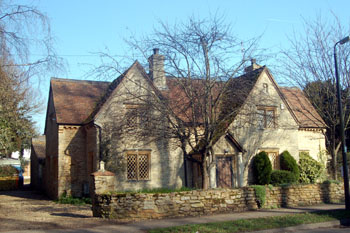![The Bedford Arms shown in red in 1804 [MA72]](/CommunityHistories/Oakley/OakleyImages/The Bedford Arms shown in red in 1804.jpg)
The Bedford Arms shown in red in 1804 [MA72]
29 Church Lane was listed by the former Department of Environment in August 1987 as Grade II, of special interest. The property dates from 1854. It was built by the Duke of Bedford, whose family owned Oakley as Lords of the Manor of Oakley Reynes from 1737 to 1918. The property is constructed of coursed limestone rubble with a clay tiled roof and comprises one storey and attics.
The house was built on a site formerly belonging to Bedford brewer George Peregrine Nash, purchased from him in 1840 by the Duke of Bedford [R6/42/1/29]. The Red Lion Public House, later called the Bedford Arms, had stood on the site since at least 1664 and had been a public house since about 1771. By the time of the conveyance to the Duke, however, the old pub had "recently been pulled down and removed". The image at the top of this page is taken from the Inclosure Map of 1804 [MA72] and shows the site when owned by Nash.
In 1918 the Duke of Bedford put the Oakley Estate up for sale by auction on 31st October. He later withdrew Oakley House from the sale as he sold it privately to his cousin the 2nd Baron Ampthill. 29 Church Lane was also withdrawn from sale. The sale particulars described the property, originally Lot 2, as follows
The Stone and Tiled House
KNOWN AS
The Estate Office
Containing nine Rooms, originally built as three cottages, and could be easily restored. Outbuildings, three Wood Barns and Earth Closets, Wash-house, together with Garden and Plantation.
Situated in OakleyVillage, opposite the Park entrance, being [Ordnance Survey map Number] 133 on the Plan, and having an area of about
0 acres 2 roods 15 poles(.597 Acre)
In hand and occupied by Mr. George Palfrey, Estate Foreman
The Rating and Valuation Act 1925 specified that every building and piece of land in the country was to be assessed to determine its rateable value. Oakley, like most of the county, was assessed in 1927 and the valuer visiting the property found that it had been converted into two semi-detached properties [DV1/C107/72-73], both still owned by Lord Ampthill.
The dwelling to the south was inhabited by William Hart who paid wages of three shillings per week and worked on the estate. His accommodation comprised two parlours and a kitchen downstairs with three bedrooms above. A barn and an earth closet still stood outside. The valuer enthused “Marvellous Cottage” but also commented: “Too big”. The tenants had to fetch water from a stand pipe.
Next door was occupied by A. Stapleton, who paid the same rent as he, too, worked on the Oakley House Estate. His accommodation consisted of one parlour and a living room downstairs with three bedrooms above. He also had a barn and an earth closet outside. Presumably the other barn and earth closet were disused.

29 Church Lane March 2011